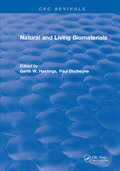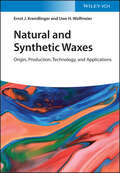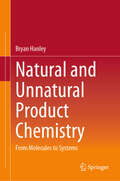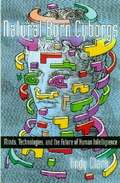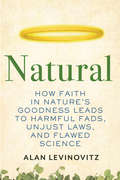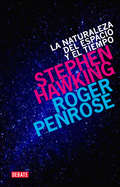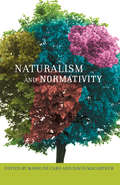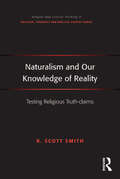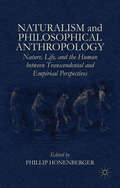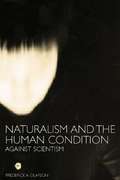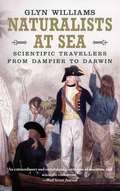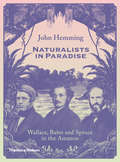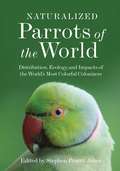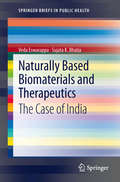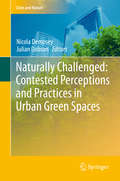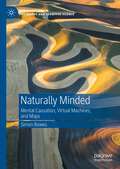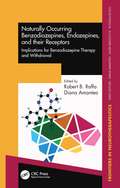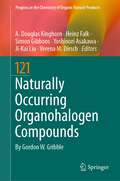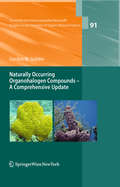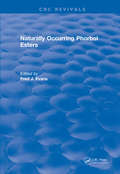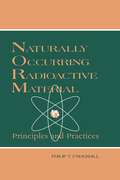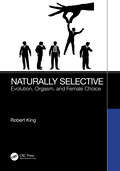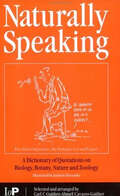- Table View
- List View
Natural and Living Biomaterials
by HastingsReasons for the study of tissue materials are discussed. Specific aspects of the musculo-skeletal system are considered, the main emphasis being on bone. Structure and different mechanical properties of parying types of bone are discussed by the authors, with the concluding chapter dealing with mechanically mediated electrical properties and their relevance to bone structure and to growth or repair.
Natural and Synthetic Waxes: Origin, Production, Technology, and Applications
by Ernst J. Krendlinger Uwe H. WolfmeierNatural and Synthetic Waxes A compilation of all relevant information for the production and use of waxes in technical applications Waxes are among the oldest organic substances used by mankind. Before all others, beeswax is known to have played a role in human history for thousands of years. But over time, many other wax species have been detected and exploited, and prepared for different utilizations. Today, we possess knowledge of a great variety of different types of waxes. Unfortunately, there still is no broadly accepted definition of a wax: for the relatively few wax chemists, waxes are usually defined by their physico-chemical properties more than by their chemical constitution. Waxes are not uniform but oligomeric and polymeric substances, not simply describable with a chemical formula. The realm of waxes encompasses fully or partly natural, refined, partly or fully synthetic products, which can be extended by “wax-like” products which do not fulfil all definition criteria. Waxes are offered in different forms like pellets, granules, powders, or micropowders. Their number of technical applications runs into thousands. However, waxes in most cases are just adjuvants or additives, and with few exceptions like candles not known to a broader public. Only few publications over the last decades tried to present a more comprehensive overview of heir chemistry, chemical composition, their physical and analytical properties, their applications, and their sometimes astonishing history. Based on personal experience and expertise, the authors intend to present an overview on the main classes of waxes, their origin, history, future, and potential fate. Economical aspects like market size and development, ecological impacts and challenges, and regulatory issues are also addressed. Waxes are indispensable products in everyday life and in industry and technology, though mostly not even visible or distinguishable to experts. They deserve more than the role of a “poor cousin” in chemistry and technology.
Natural and Unnatural Product Chemistry: From Molecules to Systems
by Bryan HanleyThis book examines and summarises the developments and changes in the approach of organic and natural product chemists over the past years, presenting both the successes and inevitable missteps. These illustrate the process from molecular isolation and structural identification, synthesis and biosynthesis and future perspectives, including the development of biological engineering. The anticipated audience are chemistry-literate scientists who are interested both in specific aspects of natural product chemistry and the illustrative process of trial, error and success which defines the area.
Natural-Born Cyborgs: Minds, Technologies, and the Future of Human Intelligence
by Andrew J. ClarkCognitive scientist Clark believes we are liberating our minds, thanks to our penchant for inventing tools that extend our abilities to think and communicate, starting with the basics of pen and paper and moving on to ever more sophisticated forms of computers. In this lively and provocative treatise, Clark declares that we are, in fact, "human-technology symbionts" or "natural-born cyborgs," always seeking ways to enhance our biological mental capacities through technology, an intriguing claim he supports with a brisk history of "biotechnology mergers," which currently range from pacemakers to the way a pilot of a commercial airplane is but one component in an elaborate "biotechnological problem-solving matrix." Cell phones, Clark explains, are "a prime, if entry-level cyborg technology," as are Internet search engines. As Clark clearly and cheerfully discusses cognitive processes, how we build "better worlds to think in," opaque versus transparent technologies, and the fluidity of our sense of self and adaptation to environmental changes, he offers hope that our brainy species can use its ever-evolving
Natural: How Faith in Nature's Goodness Leads to Harmful Fads, Unjust Laws, and Flawed Science
by Alan LevinovitzIlluminates the far-reaching harms of believing that natural means "good," from misinformation about health choices to justifications for sexism, racism, and flawed economic policies.People love what's natural: it's the best way to eat, the best way to parent, even the best way to act--naturally, just as nature intended. Appeals to the wisdom of nature are among the most powerful arguments in the history of human thought. Yet Nature (with a capital N) and natural goodness are not objective or scientific. In this groundbreaking book, scholar of religion Alan Levinovitz demonstrates that these beliefs are actually religious and highlights the many dangers of substituting simple myths for complicated realities. It may not seem like a problem when it comes to paying a premium for organic food. But what about condemnations of "unnatural" sexual activity? The guilt that attends not having a "natural" birth? Economic deregulation justified by the inherent goodness of "natural" markets?In Natural, readers embark on an epic journey, from Peruvian rainforests to the backcountry in Yellowstone Park, from a "natural" bodybuilding competition to a "natural" cancer-curing clinic. The result is an essential new perspective that shatters faith in Nature's goodness and points to a better alternative. We can love nature without worshipping it, and we can work toward a better world with humility and dialogue rather than taboos and zealotry.
Naturaleza del espacio y del tiempo
by Roger Penrose Stephen HawkingEinstein afirmaba que lo más incomprensible acerca del Universo es que es comprensible ¿estaba en lo cierto? ¿pueden la teoría cuántica de campos y la teoría de la relatividad general de Einstein, las dos teorías, más precisas y exitosas de toda la física, unirse en una única teoría cuántica de la gravedad? Aunque se ha avanzado mucho en esta búsqueda, Hawking y Penrose insisten en que es necesario llegar mucho más lejos. En La naturaleza del espacio y el tiempo , estos dos gigantes de la física entablan un debate fundamental sobre el origen del universo.Un libro escrito a cuatro manos, con un epílogo actualizado, en el que los autores resumen cómo los recientes acontecimientos han provocado que sus posturas difieran en cuestiones tan importantes como la geometría espacial del universo o la paradoja de la desaparición de información en los agujeros negros.
Naturalism and Normativity (Columbia Themes in Philosophy)
by Mario De Caro David MacarthurNormativity concerns what we ought to think or do and the evaluations we make. For example, we say that we ought to think consistently, we ought to keep our promises, or that Mozart is a better composer than Salieri. Yet what philosophical moral can we draw from the apparent absence of normativity in the scientific image of the world? For scientific naturalists, the moral is that the normative must be reduced to the nonnormative, while for nonnaturalists, the moral is that there must be a transcendent realm of norms.Naturalism and Normativity engages with both sides of this debate. Essays explore philosophical options for understanding normativity in the space between scientific naturalism and Platonic supernaturalism. They articulate a liberal conception of philosophy that is neither reducible to the sciences nor completely independent of them-yet one that maintains the right to call itself naturalism. Contributors think in new ways about the relations among the scientific worldview, our experience of norms and values, and our movements in the space of reason. Detailed discussions include the relationship between philosophy and science, physicalism and ontological pluralism, the realm of the ordinary, objectivity and subjectivity, truth and justification, and the liberal naturalisms of Donald Davidson, John Dewey, John McDowell, and Ludwig Wittgenstein.
Naturalism and Our Knowledge of Reality: Testing Religious Truth-claims (Routledge New Critical Thinking in Religion, Theology and Biblical Studies)
by R. Scott SmithPhilosophical naturalism is taken to be the preferred and reigning epistemology and metaphysics that underwrites many ideas and knowledge claims. But what if we cannot know reality on that basis? What if the institution of science is threatened by its reliance on naturalism? R. Scott Smith argues in a fresh way that we cannot know reality on the basis of naturalism. Moreover, the "fact-value" split has failed to serve our interests of wanting to know reality. The author provocatively argues that since we can know reality, it must be due to a non-naturalistic ontology, best explained by the fact that human knowers are made and designed by God. The book offers fresh implications for the testing of religious truth-claims, science, ethics, education, and public policy. Consequently, naturalism and the fact-value split are shown to be false, and Christian theism is shown to be true.
Naturalism and Philosophical Anthropology: Nature, Life, and the Human between Transcendental and Empirical Perspectives
by Phillip HonenbergerWhat is a human being? Philosophical anthropology has approached this question with unusual sophistication, experimentalism, and subtlety. This volume explores the philosophical anthropologies of Scheler, Gehlen, Plessner, and Blumenberg in terms of their relevance to contemporary theories of nature, naturalism, organic life, and human affairs.
Naturalism and the Human Condition: Against Scientism
by Frederick A. OlafsonNaturalism and the Human Condition is a compelling account of why naturalism, or the 'scientific world-view' cannot provide a full account of who and what we are as human beings.Drawing on sources including Heidegger, Merleau-Ponty, Husserl and Sartre, Olafson exposes the limits of naturalism and stresses the importance of serious philosophical investigation of human nature.
Naturalists at Sea
by Glyn WilliamsOn the great Pacific discovery expeditions of the "long eighteenth century," naturalists for the first time were commonly found aboard ships sailing forth from European ports. Lured by intoxicating opportunities to discover exotic and perhaps lucrative flora and fauna unknown at home, these men set out eagerly to collect and catalogue, study and document an uncharted natural world. This enthralling book is the first to describe the adventures and misadventures, discoveries and dangers of this devoted and sometimes eccentric band of explorer-scholars. Their individual experiences are uniquely their own, but together their stories offer a new perspective on the extraordinary era of Pacific exploration and the achievements of an audacious generation of naturalists. Historian Glyn Williams illuminates the naturalists lot aboard ship, where danger alternated with boredom and quarrels with the ships commander were the norm. Nor did the naturalists difficulties end upon returning home, where recognition for years of work often proved elusive. Peopled with wonderful characters and major figures of Enlightenment science--among them Louis Antoine de Bouganville, Joseph Banks, John Reinhold Forster, Captain Cook, and Charles Darwin--this book is a gripping account of a small group of scientific travelers whose voyages of discovery were to change perceptions of the natural world.
Naturalists in Paradise: Wallace, Bates and Spruce in the Amazon
by John HemmingThe thrilling stories of the three pioneering English naturalists' explorations and discoveries in the world's richest ecosystem One hundred and fifty years ago, the young naturalists Alfred Wallace, Henry Walter Bates, and Richard Spruce were on a journey. Their destination, Amazonia--the world's largest tropical forest with the greatest river system and richest ecosystem--was then an almost-undiscovered environment to Western explorers and scientists. In Naturalists in Paradise, Amazon expert John Hemming weaves the riveting stories of these three men's experiences in the Amazon and assesses their valuable research that drastically changed our conception of the natural world. Each of the three naturalists is famous for a particular discovery: Wallace is credited, along with Charles Darwin, for developing the theory of evolution; Bates uncovered the phenomenon of protective mimicry among insects; and Spruce transported the quinine-bearing Cinchona tree to India, saving countless lives from malaria. Drawing on the letters and books of the three naturalists, Hemming reaches beyond the well-known narratives, offering unrivaled insight into the often lawless frontier life in South America as seen through the lives of the great pioneers of modern disciplines: anthropology, tribal linguistics, archaeology, and every branch of natural science.
Naturalized Parrots of the World: Distribution, Ecology, and Impacts of the World's Most Colorful Colonizers
by Stephen Pruett-JonesA remarkable exploration of naturalized parrots, among the most widely distributed birds in the worldThere are more than 350 species of parrots in the world, and approximately 300 of these species have been transported to other countries through the caged pet trade. Whether through escaped captivity or purposeful release, many of these parrots are now breeding in new habitats. Indeed, no less than 75 species of parrots have established breeding populations in countries where they were introduced, and parrots are now among the most widely distributed group of birds. Naturalized Parrots of the World is the first book to examine this specific avian population.Bringing together the work of leading researchers in one convenient volume, this book explores the biology of naturalized parrots and their interactions with native ecosystems. Experts discuss the global distribution of parrots, their genetics, conservation implications, and human responses to these birds. They also consider debates surrounding management issues and the lack of consensus around nonnative species in the wild. Later chapters feature case studies of the two most successful species—the Rose-ringed Parakeet and Monk Parakeet—as well as studies of the introduced parrot species located in specific countries and regions, including the United States, United Kingdom, Spain, Portugal, northern Europe, South Africa, and Australia.Highlighting critical aspects of conservation biology and biodiversity, Naturalized Parrots of the World will be an invaluable resource for parrot owners, ornithologists, conservation biologists, and birdwatchers.
Naturally Based Biomaterials and Therapeutics
by Sujata K. Bhatia Veda EswarappaThis book advances biomedical innovations to address the plethora of health problems afflicting the developing world. A panoply of cultural, economic, infrastructural, and other factors prevent many interventions currently popular in the developed world from being similarly effective in the developing world. This book discusses less-traditional approaches, such as naturally based biomaterials and therapeutics, an area that has traditionally been overlooked but has also demonstrated impressive potential for health applications in recent years. This book explores precisely the kinds of applications which can enable countries like India to access more effective, inexpensive treatments while also taking more ownership of their healthcare technologies and innovations.
Naturally Challenged: Contested Perceptions and Practices in Urban Green Spaces (Cities and Nature)
by Nicola Dempsey Julian DobsonThis book aims to understand how the wellbeing benefits of urban green space (UGS) are analysed and valued and why they are interpreted and translated into action or inaction, into ‘success’ and/or ‘failure’. The provision, care and use of natural landscapes in urban settings (e.g. parks, woodland, nature reserves, riverbanks) are under-researched in academia and under-resourced in practice. Our growing knowledge of the benefits of natural urban spaces for wellbeing contrasts with asset management approaches in practice that view public green spaces as liabilities. Why is there a mismatch between what we know about urban green space and what we do in practice? What makes some UGS more ‘successful’ than others? And who decides on this measure of ‘success’ and how is this constituted? This book sets out to answer these and related questions by exploring a range of approaches to designing, planning and managing different natural landscapes in urban settings.
Naturally Minded: Mental Causation, Virtual Machines, and Maps (New Directions in Philosophy and Cognitive Science)
by Simon BowesThis book is an empirically informed investigation of the philosophical problem of mental causation, and a philosophical investigation of the status of cognitive scientific generalisations. If there are mental causes which can be classified in a way useful for predicting and explaining, then they are natural kinds. First. we develop an account of natural kinds that accommodates the cognitive. Second, we show how statements using these are not reducible to statements about physical kinds, involving biological and social facts. Finally, Virtual Machine Functionalism is defended as the correct account of the relationship between cognition and the material world.
Naturally Occurring Benzodiazepines, Endozepines, and their Receptors: Implications for Benzodiazepine Therapy and Withdrawal (Frontiers in Neurotherapeutics Series)
by Robert B. Raffa Diana AmanteaUnderstanding and addressing the current opioid crisis requires knowledge of endogenous opioids (endorphins and enkephalins), but there is now evidence for a benzodiazepine crisis. Are there endogenous benzodiazepine-like substances—and what do they do? How do they affect antianxiety drugs and their adverse effects? Do they explain enigmatic prolonged benzodiazepine withdrawal syndrome? This book raises important questions about the clinical consequences of ignoring the existence of or understanding the potential influence of endogenous benzodiazepines on the therapeutic effect of benzodiazepines, their adverse effects, and the problems of withdrawal from them and other benzodiazepine receptor agonists. FEATURES Discusses endogenous benzodiazepine-like substances—what do they do, and do they affect antianxiety drugs and their adverse effects? Presents information on enigmatic prolonged benzodiazepine withdrawal syndrome Describes the compounds acting at the BDZ binding sites, both exogenous (classical BDZ drugs and BDZ from food and plants) and endogenous (endozepines) Assesses the putative interactions in physiology, pathology, and pharmacology of the compounds acting at the BDZ binding sites Dr. Raffa is Adjunct Professor at the University of Arizona College of Pharmacy and Professor Emeritus at Temple University School of Pharmacy. He has co-authored or edited several books on pharmacology and thermodynamics, is a co-editor of two journals, is a past president of the Mid-Atlantic Pharmacology Society, and is the recipient of research and teaching awards. Dr. Amantea is Associate Professor of Pharmacology at the Department of Pharmacy, Health and Nutritional Sciences of the University of Calabria (Italy), where she is the leader of the Stroke Research Unit at the Section of Preclinical and Translational Pharmacology operating in the frame of the Italian Stroke Organization (ISO) Basic Science. She is a member of the Editorial Board and the Guest Editor of the 2016 Neuroscience section of Current Opinion in Pharmacology (Elsevier), and the founder and the editor of the CRC Press Frontiers in Neurotherapeutics series.
Naturally Occurring Organohalogen Compounds (Progress in the Chemistry of Organic Natural Products #121)
by A. Douglas Kinghorn Heinz Falk Simon Gibbons Yoshinori Asakawa Ji-Kai Liu Verena M. DirschThe present volume is the third in a trilogy that documents naturally occurring organohalogen compounds, bringing the total number — from fewer than 25 in 1968 — to approximately 8,000 compounds to date. Nearly all of these natural products contain chlorine or bromine, with a few containing iodine and, fewer still, fluorine. Produced by ubiquitous marine (algae, sponges, corals, bryozoa, nudibranchs, fungi, bacteria) and terrestrial organisms (plants, fungi, bacteria, insects, higher animals) and universal abiotic processes (volcanos, forest fires, geothermal events), organohalogens pervade the global ecosystem. Newly identified extraterrestrial sources are also documented. In addition to chemical structures, biological activity, biohalogenation, biodegradation, natural function, and future outlook are presented.
Naturally Occurring Organohalogen Compounds - A Comprehensive Update
by Gordon W. GribbleDespite the long association of organohalogen compounds with human activities, nature is the producer of nearly 5,000 halogen-containing chemicals. Once dismissed as accidents of nature or isolation artifacts, organohalogen compounds represent an important and ever growing class of natural products, in many cases exhibiting exceptional biological activity. Since the last comprehensive review in 1996 (Vol. 68, this series), there have been discovered an additional 2,500 organochlorine, organobromine, and other organohalogen compounds. These natural organohalogens are biosynthesized by bacteria, fungi, lichen, plants, marine organisms of all types, insects, and higher animals including humans. These compounds are also formed abiogenically, as in volcanoes, forest fires, and other geothermal events.In some instances, natural organohalogens are precisely the same chemicals that man synthesizes for industrial use, and some of the quantities of these natural chemicals far exceed the quantities emitted by man.
Naturally Occurring Phorbol Esters
by EvansThis book discusses the topic of naturally occurring phorbol esters. Chapters include; environmental hazards of diterpene esters from plants, multi-stage carcinogenesis and the biological effects of tumor promoters, review of the family euphorbiaceae, biosynthetic and chemosystematic aspects of the euphorbiacea and thymelaeaceae, non-diterpenoid constituents of euphorbiacea, macrocyclic diterpenes of the family euphorbiacea, phorbol: its esters and derivatives, the daphnane polyol esters, the ingenane polyol esters, and the biochemical mechanism of action of phorbol ester.
Naturally Occurring Radioactive Materials: Principles and Practices
by T.Rick IrvinManagement of Naturally Occurring Radioactive Materials - known in the industry as NORM -has become an important part of the regular training required for workers in oil and gas production, refinery and petrochemical manufacturing, and in certain types of mining. Proper handling of NORM-contaminated wastes and use of appropriate radiation detection and protective equipment are now understood to be important components of good worker safety programs. Until now, no practical, easy-to-read, book was available to supplement worker training courses on NORM management. Naturally Occurring Radioactive Materials: Principles and Practices fills this void by providing, in a single publication, an ideal reference for industry managers, supervisors and line personnel. The book stresses the proper handling and management of NORM contaminated wastes and provides a firm understanding of the chemical properties of radioactive agents, their toxicological effects, and the appropriate containerization and disposal methods for these materials.
Naturally Selective: Evolution, Orgasm, and Female Choice
by Robert KingResearchers of human behaviour have identified an "orgasm gap": Men usually orgasm during intercourse, whereas women often do not. This book addresses this mystery. The two leading explanations are either that women are “psychologically broken” - Freud’s theory – or badly designed – the “by-product theory.” However, there is a much more compelling third explanation. Evolutionary biology, anatomy, physiology, and direct sex research suggest women have evolved under their own selection pressures and orgasm is a fitness-increasing consequence of such selective factors. This is revealed in their patterns of orgasmic response, which are neither random nor inexplicable.Key Features• Synthesizes decades of peer-reviewed sex research in anatomy, biology, physiology, and behavior.• Engagingly written based on feedback from students, peers, and interested lay persons.• Makes sense of the “orgasm gap” between men and women.• Provides a wider context of human sexual dimorphism and mutual sexual selection.• Balances sex research and real-world research and practical applications.
Naturally Speaking: A Dictionary of Quotations on Biology, Botany, Nature and Zoology, Second Edition
by C.C. Gaither Alma E Cavazos-GaitherIn these days of ever-increasing specialization, it is important to gain a broad appreciation of the subject. With this in mind, Naturally Speaking: A Dictionary of Quotations on Biology, Botany, Nature and Zoology, Second Edition presents the largest compilation of published quotations on the natural world available so that readers can get a feel
Naturalness, String Landscape and Multiverse: A Modern Introduction with Exercises (Lecture Notes in Physics #979)
by Arthur HebeckerThis book presents a string-theoretic approach to new ideas in particle physics, also known as Physics Beyond the Standard Model, and to cosmology. The concept of Naturalness and its apparent violation by the low electroweak scale and the small cosmological constant is emphasized. It is shown that string theory, through its multitude of solutions, known as the landscape, offers a partial resolution to these naturalness problems as well as suggesting more speculative possibilities like that of a multiverse. The book is based on a one-semester course, as such, it has a pedagogical approach, is self-contained and includes many exercises with solutions. Notably, the basics of string theory are introduced as part of the lectures. These notes are aimed at graduate students with a solid background in quantum field theory, as well as at young researchers from theoretical particle physics to mathematical physics. This text also benefits students who are in the process of studying string theory at a deeper level. In this case, the volume serves as additional reading beyond a formal string theory course.
Nature (Merit Badge Series)
by Boy Scouts of AmericaThis book takes the reader to a world of nature to learn about Wildlife Communities, Birds, Mammals, Reptiles and Amphibians, Insects and Spiders, Fish, Mollusks and Crustaceans, Plants, Soil and Rocks.
